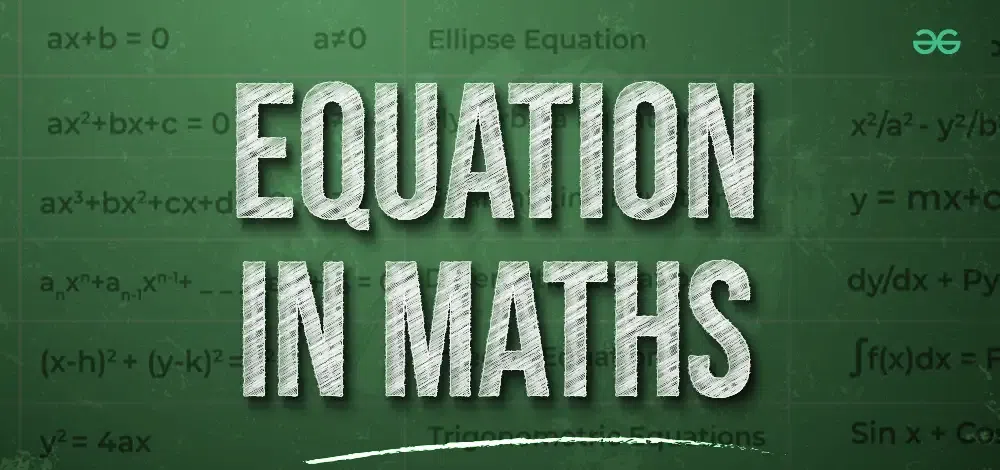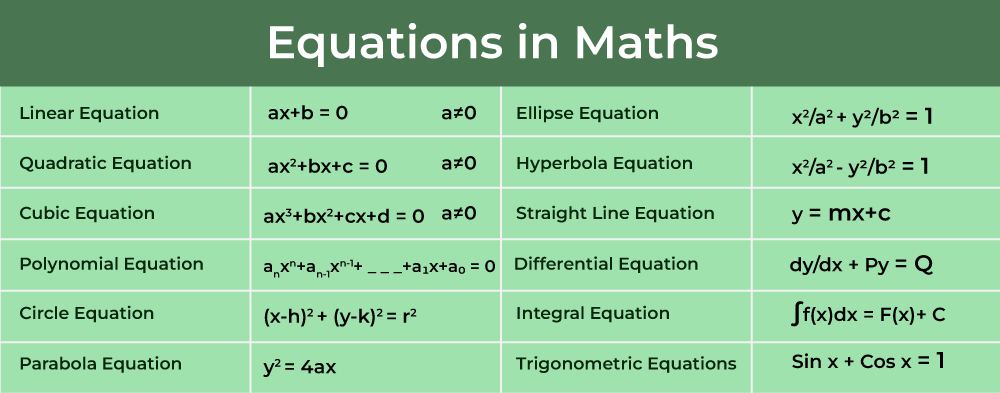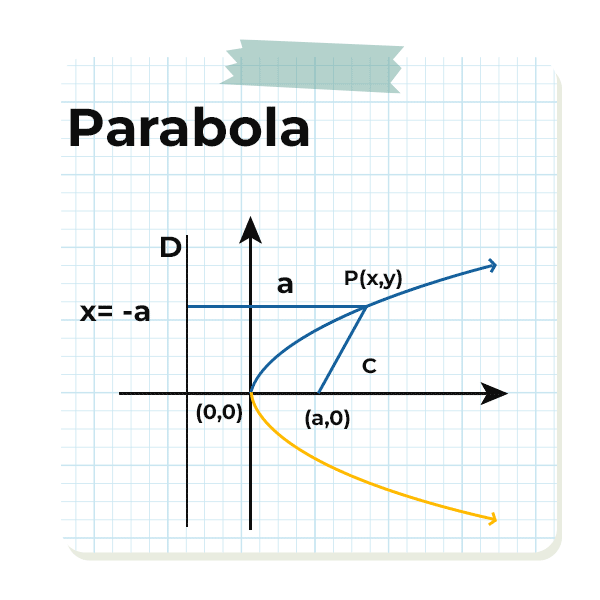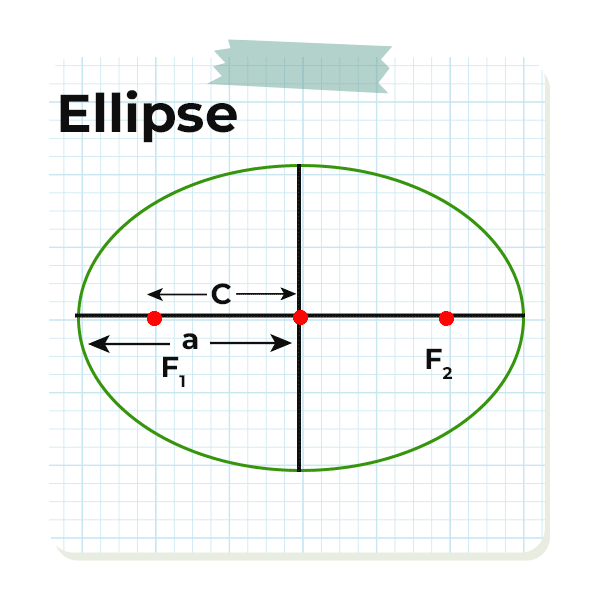
|
|
Equations in Maths are statements that equates two terms involving variables and constants. Equations are a form of statement that shows that the two expressions are equal. There are various types of equations – Linear, Quadratic, Polynomial, Logarithmic, Trigonometric as well as some other shape equations like equations of Line, Circle, Ellipse, Parabola, etc. This article talks about different equations along with systems of equations, both linear and non-linear, providing techniques for effective solutions, along with methods to solve different type of equations like linear, quadratic, polynomial, exponential, or trigonometric. This article also discusses about real-world applications of these mathematical equations, at the end some practice problems have been offered to learners.
Table of Content What is an Equation?Equations are mathematical statement that shows the equality between two mathematical expressions. An equation contains variables (letters), numbers, mathematical symbols, and operations. An equation shows two parts that are separated by an equal sign (=), where the left-hand side is called LHS and the right-hand side is called RHS. The equation tells us that LHS equals RHS. Definition of Equation
Degree of equationThe degree of an equation is the highest power of the variable in the equation. It determines the equation’s complexity and the shape of its graph.
Difference between Expression and EquationAn expression represents a value and has no equality sign, e.g., 3x+23x + 23x+2. An equation states that two expressions are equal, e.g., 3x+2=73x + 2 = 73x+2=7. The following table shows difference between Expression and Equation
Types of EquationsThere are range of equations that solve different purposes and show the connection between quantities and situations. Some key equation types in mathematics include linear equations, quadratic equations, polynomial equations, logarithmic equations, exponential equations, and trigonometric equations. Let’s delve into each of them to gain a better understanding.
Linear EquationsThe linear equation is an equation that contains a constant, variable, or product of a constant and shows the relationship between variables and constant. Linear equations can be represented on a single-line graph. The The general form of a linear equation is:
Example of Linear Equation
Quadratic EquationsIn a quadratic equation, a variable gets raised to the power of 2, making a U-shaped curve when graphed. A quadratic equation can be written as:
Example of Quadratic Equation
Some other examples include:
Polynomial EquationsA polynomial equation is a mathematical expression that includes variables, exponents (such as squares and cubes), and coefficients (numbers). The degree of the equation depends on the highest exponent present. When the highest exponent (or power) of any variable is 2, then a quadratic equation will be formed. The general form of the polynomial equation is given as:
Logarithmic EquationsLogarithmic equations use logarithmic functions, which are the reverse of exponential functions. In other words, these equations help us solve for the unknown variable that is found as an exponent in an exponential expression. The general form of a logarithmic equation is:
Exponential EquationsAn exponential equation is a maths equation that uses an exponential function. This type of equation can be written as:
In the equation, x is a variable and a is a real number which is referred to as the base of the function, with a being greater than 0. The exponential function represents repeated multiplication or growth at a consistent percentage rate. Typically, the most widely utilized base for exponential functions is , which is an approximately equal value of 2.71828. The general form of an exponential equation is:
Trigonometric EquationsTrigonometry deals with equations that involve trigonometric ratios like sine, cosine, tangent, cotangent, secant, and cosecant. These equations relate the angles and side lengths in triangles. For example, the equation sinθ = 0.5 represents a trigonometric equation. Let’s consider a right-angled triangle with ∠ an acute angle. The following trigonometry ratios can be derived:
These trigonometry ratios can be calculated at different angles. Given below is the Table for trigonometry ratio values at different angles.
Read More about Trigonometric Table. Some Special EquationsApart from the equations that are just discussed above, there are some special equations as well, which can be called as equations of shapes, that are discussed further. Equation of a LineThe general form of the equation of a line in two variables and first degree is Ax+By+C=0 A, B, and C are constant real numbers and a graphical representation of the line equation will give a straight line The equation of a line in slope intercept form can be written as:
Where ‘m’ is the slope of the line and ‘c’ is the intercept of y. The general equation of line can be written in slope intercept form as:
Equation of CircleThe general equation of a circle is x² + y²+ 2gx + 2fy + c = 0 , where g, f and c are constants. This form allows us to represent circles with centers not necessarily at the origin and can represent circles with various characteristics. The values of g,f and c determine the center, radius, and other properties of the circle.
When the center of a circle is at the origin (0, 0), then the equation will be: x²+y²= r² , where r is the radius of the circle. This equation represents a circle with center at the origin with a radius of r.
To express the equation of a circle with center (h,k) and radius r: (x-h)²+(y-k)² = r². In this equation, the values (h,k) represent the coordinates of the center, while r represents the radius of the circle. Essentially, this equation defines a circle centered at (h,k) with a radius equal to r. Equation of ParabolaA parabola is a curve that looks the same on both sides and has three important parts, namely, the focus, directrix, and axis of symmetry. The focus is in the middle on the axis of symmetry, while the directrix is a parallel line. The parabola is consist of points where the distance from the focus is the same as the distance from the directrix and the sharpest point on the parabola is called the vertex.
The general equation of a parabola is given as:
Equation of EllipseAn ellipse can be defined as the set of points where the sum of the distances from any point on the shape to two fixed points (known as foci) remains constant. A circle is also an ellipse with it’s foci at the same point. Ellipse can be defined by it’s two axis x-axis and y-axis called as mazor axis and minor axis.
The general form of ellipse equation is:
Equation of HyperbolaA hyperbola belongs to a group of curves called conic sections. The equation that describes a hyperbola depends on its orientation and the location of its center.
Here are the standard form equations for hyperbolas:
For a horizontal hyperbola with its center at the point (h, k), a horizontal major axis, and a vertical minor axis, the equation is as follows:
The equation for a vertical hyperbola with its center at the point (h, k), a vertical major axis, and a horizontal minor axis can be expressed as:
Equation in CalculusThere are two branches of Calculus namely, differential calculus and integral calculus which deals with finding derivative and antiderivative of a function respectively. The equation in differential and integral calculus are discussed below: Differential EquationA differential equation involves terms and derivatives of a variable (dependent) with respect to another (independent). For instance, dy/dx = f(x), where x is independent and y is dependent. It represents a rate of change and describes how one quantity changes in relation to another. Various formulas exist for solving these equations. The order of a differential equation is determined by the highest derivative present. For example, dy/dx = 7x + 8 is a first-order equation, while (d²y/dx²) + 2(dy/dx) + y = 0 is a second-order one. First-order equations involve only the first derivative, like dy/dx, while second-order equations include the second derivative, like d²y/dx². The degree of a differential equation is the highest power of the derivative it contains. It’s determined by looking at the derivatives in the equation. For example, if an equation has a second derivative like (d²y/dx²), it’s a first-degree equation. Some equations may not have a defined degree if they don’t fit a polynomial pattern. Integral EquationsIntegration is like adding up specific pieces discrete data. It’s used to find functions that describe area, displacement, or volume, which are made up of many small pieces that can’t be measured separately. In math, calculus uses a concept called “limits” to get accurate answer. Limits are a way to look at what happens to the points on a graph as they come closer until the distance between two points are equal to zero. There are basically two problems where integration is used:
Integral Calculus: Integral calculus is all about these two problems. It has two parts: definite (specific area) and indefinite (finding the original function). The Fundamental Theorem of Calculus connects differentiation and integration. Definite Integral: An integral that contains the upper and lower limits then it is a definite integral. On a real line, x is restricted to lie. Riemann Integral is the other name of the Definite Integral. A definite Integral is represented as
Indefinite Integral: An indefinite integral doesn’t have these upper and lower limits. It’s written like this:
In this equation, C is any constant, and f(x) is the function we’re integrating, also known as the integrand. It means finding the function that, when you take its derivative, gives you f(x). Systems of EquationsSystems of equations are mathematical expressions that involve multiple variables. The goal is to find values for these variables that satisfy all the given equations at the same time. There are different methods to solve system of linear equations, such as substitution, elimination, and graphical representation. The outcomes can include a single solution, no solution when lines are parallel, or an infinite number of solutions when lines coincide System of Linear EquationsA system of linear equations is a set of two or more equations in which the variables have exponents of 1 and are related linearly, meaning they form straight lines when graphed. The goal is to find values of the variables that satisfy all the equations in the system simultaneously. System of Non-Linear EquationsA system of non-linear equations consists of two or more equations where the relationships between variables are not linear. These relationships involve variables raised to powers other than 1, such as squares, cubes, or other nonlinear functions. Solving these systems can be more complex compared to linear systems because nonlinear equations can produce curves instead of straight lines when graphed. Example of System of Non-Linear Equations
In this system, x and y are the variables, and the equations involve nonlinear terms, such as x² and xy. Solving such systems typically requires advanced techniques and may not always have analytical solutions. How to Solve Systems of Equations?There are 3 ways of solving systems of equations- Graphical method, substitution method and elimination method Substitution MethodThe substitution method involves solving one equation for one variable and then substituting that expression into the other equation. This reduces the system to a single equation with one variable, which can be solved.
To solve a pair of equations using substitution, first solve one of the equations for one of the variables. Then substitute the result for that variable in the other equation. Step 1: Solve any one equation for x
Step 2: Substitute the value of x that we just got in the other equation 3x – 2y = 4
Step 3: Substitute this value of y in equation (3)
Graphical MethodThe graphical method involves graphing each equation on the same coordinate plane and finding the point(s) where the graphs intersect. These points represent the solutions to the system of equations. For the given
Plot both the equations on the graph, the point where both the equations intersect is the solution. Putting the values of x and y we can find that the graph of two lines intersect at (3, 5/2) which is the required solution of the graph. Learn More, Graph of Linear Equations in Two Variables Elimination MethodThe elimination method involves adding or subtracting equations to eliminate one variable. This creates a new equation with only one variable, which can be solved. Taking the same equation to solve using elimination method
Step 1: To make the coefficients of variable x in both equations equal, multiply equation (1) by 3 and equation (2) by 2. The equation formed are
Step 2: Subtract like terms in equation (2) from equation (1)
Step 3: Put the value of y in equation (2)
Solving EquationsSolving equations involves finding the values that make a given equation true. There are various techniques for solving different types of equations, such as linear, quadratic, polynomial, exponential, and trigonometric equations. Each type of equation requires its own specific method or function to find the solutions, providing a range of versatile methods for tackling mathematical problems. Solving Linear EquationsExample: Check if 5 = 2x +3 Solution:
Solving Quadratic EquationsThere are various ways of solving a quadratic equation- factor method, completing squares method and quadratic formula. The quadratic formula to find variable x in a quadratic equation ax2 + bx + c = 0 can be written as:
Let us solve a quadratic equation x2-3x=28 using the quadratic formula Step 1: convert the given equation into the standard quadratic equation ax2+bx+c=0
Step 2: Put the values of a,b, and c in the quadratic formula
Solving Polynomial EquationsThere are various ways of solving a polynomial equation based on its complexity. The main methods to solve a polynomial equations are: Roots of a Polynomial: A root of a polynomial is a value of x that makes polynomial equivalent to zero, i.e, P(x)=0 Factorization and Division: To find the roots of a mathematical expression, the common technique used is called factorization of polynomial. This method involves breaking down a complex expression into simpler components that are more easy to solve. For instance, if there is an equation like x²-4, by dividing the equation into (x-2)(x+2) and then solve for x by equating each part to zero: x-2=0 and x+2=0 . The values of x that make each component zero correspond to the roots of the equation. Complex Roots: Some polynomials, such as x²+1 , do not have real number roots. However, by considering complex numbers, every non-constant polynomial has at least one root. This is known as the fundamental theorem of algebra. Solving Exponential EquationsExponential Equations looks complex which requires basic algebra knowledge. In mathematics there are mainly three types of exponential equations to solve and hence there are three methods to solve them, namely:
Solving Trigonometric EquationsTrigonometric equations contain expressions with trigonometric functions such as sine, cosine, and tangent. To find the solutions for a variable x within the range 0 ≤ x ≤ 2π, we identify the principal solutions. If these solutions incorporate an integer ‘n,’ they are known as general solutions. The table below shows the general trigonometric equations with their general solutions.
Algebraic EquationAn Algebraic equation is a form of equation that consistes of variables, coefficients and constants. Algebraic equation can be represented as P = 0 Where, P is a polynomial. According to P=0, it can be said that, an algebraic equation has polynomial on onne side and is set equal to zero. For example, in algebraic equation x-10 = 0, x-10 is a polynomial and it is set qual to zero. An algebraic equation is suppose to have balance on booth side to avoid any error, which means if there is any change on LHS side there will be equal chnge on RHS side as well. To understand through an equation, consider an equation 2+2 = 4, this equation is balanced on both side , but if 5 is added on LHS side the equation will become 2+2+5 = 4, which is not correct. So, in order to make it balances 5 is supposed to be add on RHS side. This same will apply on multiplication, division, subtraction or any opertion that can be used From the various types of algebraic equations, few of them are:
Algebraic Equation Formulas
Parts of Algebraic EquationThere are different parts of equation. Let’s break an equation say, 2x+5 = 11
Application of EquationsThe applications of Equations are mentioned below:
Solved Examples on EquationsExample 1: 3x + 4 = 10 Solution:
Example 2: x2 – 5x + 6 = 0 Solution:
Example 3: 3x – 2(2x + 1) = 5 Solution:
Example 4: log(x) = 2 Solution:
Example 5: 2(2x+1) = 16 Solution:
Practice Problems on EquationsQ1. Solve for x in the exponential equation: 2x = 16 Q2. Factor the polynomial equation: x3-8x2+16x = 0 Q3. Tina is saving money for a new bicycle. She currently has ₹80 saved up and plans to save an additional amount each week. After 7 weeks, she wants to have ₹220 in total. What is the amount Tina plans to save each week? Q4. Solve this quadratic equation: 2x2 -5x+3=0 Q5. A population of bacteria doubles every hour. If there are initially 100 bacteria, how many will there be after 5 hours? Q6. John and Sarah are buying apples and oranges. John buys 4 apples and 3 oranges for ₹6. Sarah buys 2 apples and 5 oranges for ₹5. What is the cost of one apple and one orange? FAQs on Equations in Maths1. How can I solve a System of Equations?
2. What is Algebraic Equation?
3. Is 20+3 an algebraic equation?
4. What is the difference between an Equation and a Function?
5. What is Linear Equation?
6. What are the different ways of Solving a Quadratic Equation?
7. What is the use of a Graphical Representation of an Equation?
8. What is the Graph of a Quadratic Equation?
9. What is Foci and where can we find Foci in terms of Mathematics?
10. What is the Equation and Formula?
11. What is an Equation in Simple Form?
12. What is Bernoulli’s Equation in Maths?
|
Reffered: https://www.geeksforgeeks.org
| Class 10 |
Type: | Geek |
Category: | Coding |
Sub Category: | Tutorial |
Uploaded by: | Admin |
Views: | 9 |




